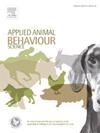Light spectrum and intensity preferences of fast- and slower-growing broilers vary by age, behaviour and time of day
IF 2.2
2区 农林科学
Q1 AGRICULTURE, DAIRY & ANIMAL SCIENCE
引用次数: 0
Abstract
Light is an important management factor in broiler production. However, our knowledge of broiler preferences for different lighting conditions is limited, especially regarding changes in preference with age, across breeds with different growth rates and for different behaviours. Here we investigated preferences of fast- (Ross 308; R) and slower-growing (Hubbard JA757; H) broilers for a combination of light spectra (sky blue (S) and green (G) light) and intensities (15 and 100 lux), examining over time 1) where broilers chose to spend most time, 2) what behaviours were performed, and 3) the feed intake of the birds. A choice test setup was applied, where broilers were housed in replicate pens with four compartments that they could freely move between, with the four light conditions (15S, 15G, 100S and 100G) provided in the separate compartments. The birds’ locations were scored every five minutes, two days a week, using an automated computer vision approach. Behaviour was observed through instantaneous scan sampling at five ages per breed and feed intake was recorded per compartment approximately every week. It was observed that broilers initially spent most of the daytime in bright, G light (week 1), before a preference for bright, S light came up (weeks 2–3 for R broilers, week 2 for H broilers) and then no clear preference was visible for weeks 4–6 for R and 3–6 for H broilers. For H broilers, a preference for low intensity light was shown in weeks 7–8 with no clear preference for G or S light. We observed differences in the proportions of behaviours shown in the light treatments, with more inactive behaviour in dimmer and S light conditions and more active behaviours in brighter and/or G light conditions. Furthermore, there was an initial higher feed intake in 100G for R birds, and a higher feed intake in 100S than in 15S later on. For H birds, there was a higher feed intake at 15 lux than at 100 lux (for both spectra) at the end of the production period. Overall, the outcomes of this study highlight that broiler preferences for specific light conditions differ between breeds, ages and for different behaviours. These outcomes can inform the development of functional lighting programs for fast- and slower-growing broilers and suggest that providing broilers with variation in light conditions in space and time may better suit the birds’ behavioural needs and preferences, hereby potentially improving broiler welfare.
求助全文
约1分钟内获得全文
求助全文
来源期刊

Applied Animal Behaviour Science
农林科学-行为科学
CiteScore
4.40
自引率
21.70%
发文量
191
审稿时长
18.1 weeks
期刊介绍:
This journal publishes relevant information on the behaviour of domesticated and utilized animals.
Topics covered include:
-Behaviour of farm, zoo and laboratory animals in relation to animal management and welfare
-Behaviour of companion animals in relation to behavioural problems, for example, in relation to the training of dogs for different purposes, in relation to behavioural problems
-Studies of the behaviour of wild animals when these studies are relevant from an applied perspective, for example in relation to wildlife management, pest management or nature conservation
-Methodological studies within relevant fields
The principal subjects are farm, companion and laboratory animals, including, of course, poultry. The journal also deals with the following animal subjects:
-Those involved in any farming system, e.g. deer, rabbits and fur-bearing animals
-Those in ANY form of confinement, e.g. zoos, safari parks and other forms of display
-Feral animals, and any animal species which impinge on farming operations, e.g. as causes of loss or damage
-Species used for hunting, recreation etc. may also be considered as acceptable subjects in some instances
-Laboratory animals, if the material relates to their behavioural requirements
 求助内容:
求助内容: 应助结果提醒方式:
应助结果提醒方式:


